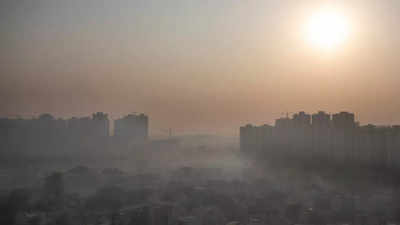- News
- City News
- mumbai News
- SAFAR’s air quality forecasting framework for Mumbai, Delhi, Pune and Ahmeadabad gets global acknowledgement
Trending
This story is from September 22, 2021
SAFAR’s air quality forecasting framework for Mumbai, Delhi, Pune and Ahmeadabad gets global acknowledgement
For the first time, an official Indian model for forecasting air quality in India's four largest cities -- Delhi, Mumbai, Pune, and Ahmedabad -- as mandated by the NCAP plan and devised by SAFAR, has been accepted internationally in a peer-reviewed Elsevier journal.

Photo used for representational purpose only
MUMBAI: For the first time, an official Indian model for forecasting air quality in India's four largest cities -- Delhi, Mumbai, Pune, and Ahmedabad -- as mandated by the National Clean Air Programme (NCAP) plan and devised by System of Air Quality and Weather Forecasting and Research (SAFAR), has been accepted internationally in a peer-reviewed Elsevier journal.
The acknowledgement of the model may have a big impact on air quality forecasting methods nationwide, formalising the same framework for all 132 non-attainment cities in the country.
Under the Union earth sciences ministry, this model of SAFAR is aimed at informing people, decision-makers, and researchers to take up actions on the ground.
India currently has 132 non-attainment/million-plus cities under its NCAP program which seeks to achieve a 20 per cent to 30 per cent reduction in Particulate Matter (PM) concentrations by 2024, keeping 2017 as the base year.
Air pollution is likely to reduce the life expectancy of about 40 per cent of Indian citizens by more than nine years, a recent report - Air Quality Life Index (AQLI) 2019 - released by the Energy Policy Institute at the University of Chicago (EPIC) said.
The Indian Institute of Tropical Meteorology (IITM-Pune) collaborated with the India Meteorological Department and Bhubaneshwar's Utkal University on the study titled 'India’s maiden air quality forecasting framework for megacities of divergent environments: The SAFAR-project'.
The findings have found a placement in the internationally acclaimed Elsevier Journal recently.
According to SAFAR’s founder project director Dr Gufran Beig, the SAFAR framework helps formulate micro specific air action plans based on robust science. “SAFAR’s forecasting model is comparable to the framework by the
United States Environmental Protection Agency (US-EPA),” he said.
Air pollution monitoring suggests that the most dominating emission source of PM2.5 is transportation, whose share is found to be 41 per cent in Delhi, followed by 40 per cent in Pune, 35 per cent in Ahmedabad and 31 per cent in Mumbai. The uncontrolled combustion pattern in the highly-dense slum population is significantly high in Mumbai.
The share of biofuel emissions is highest in Mumbai (15.5 per cent), followed by Pune (11.4 per cent), Ahmedabad (10.2 per cent) and Delhi (3 per cent).
Industrial emissions mainly consist of emissions that were found to be highest in Mumbai (31.1 per cent), (21.6 per cent) in Pune, followed by Ahmedabad (18.8 per cent) and Delhi (18.6 per cent).
The acknowledgement of the model may have a big impact on air quality forecasting methods nationwide, formalising the same framework for all 132 non-attainment cities in the country.
Under the Union earth sciences ministry, this model of SAFAR is aimed at informing people, decision-makers, and researchers to take up actions on the ground.
India currently has 132 non-attainment/million-plus cities under its NCAP program which seeks to achieve a 20 per cent to 30 per cent reduction in Particulate Matter (PM) concentrations by 2024, keeping 2017 as the base year.
Non-attainment cities are those that do not meet the prescribed air quality standards set by the Union environment ministry.
Air pollution is likely to reduce the life expectancy of about 40 per cent of Indian citizens by more than nine years, a recent report - Air Quality Life Index (AQLI) 2019 - released by the Energy Policy Institute at the University of Chicago (EPIC) said.
The Indian Institute of Tropical Meteorology (IITM-Pune) collaborated with the India Meteorological Department and Bhubaneshwar's Utkal University on the study titled 'India’s maiden air quality forecasting framework for megacities of divergent environments: The SAFAR-project'.
The findings have found a placement in the internationally acclaimed Elsevier Journal recently.
According to SAFAR’s founder project director Dr Gufran Beig, the SAFAR framework helps formulate micro specific air action plans based on robust science. “SAFAR’s forecasting model is comparable to the framework by the
United States Environmental Protection Agency (US-EPA),” he said.
Air pollution monitoring suggests that the most dominating emission source of PM2.5 is transportation, whose share is found to be 41 per cent in Delhi, followed by 40 per cent in Pune, 35 per cent in Ahmedabad and 31 per cent in Mumbai. The uncontrolled combustion pattern in the highly-dense slum population is significantly high in Mumbai.
The share of biofuel emissions is highest in Mumbai (15.5 per cent), followed by Pune (11.4 per cent), Ahmedabad (10.2 per cent) and Delhi (3 per cent).
Industrial emissions mainly consist of emissions that were found to be highest in Mumbai (31.1 per cent), (21.6 per cent) in Pune, followed by Ahmedabad (18.8 per cent) and Delhi (18.6 per cent).
End of Article
FOLLOW US ON SOCIAL MEDIA











